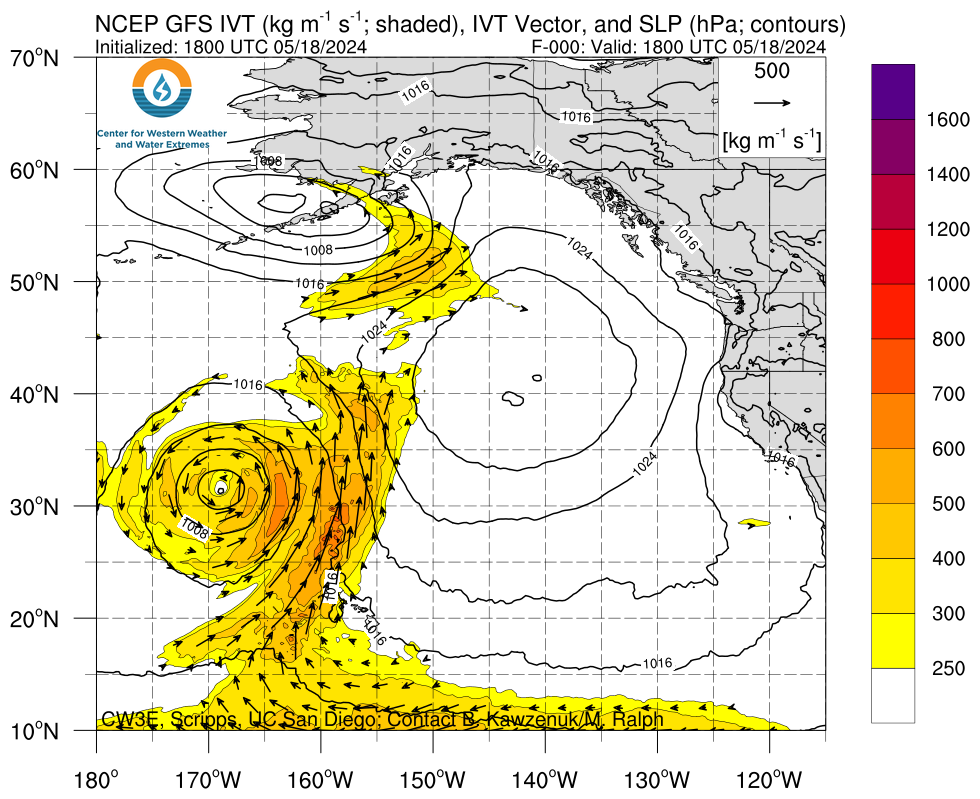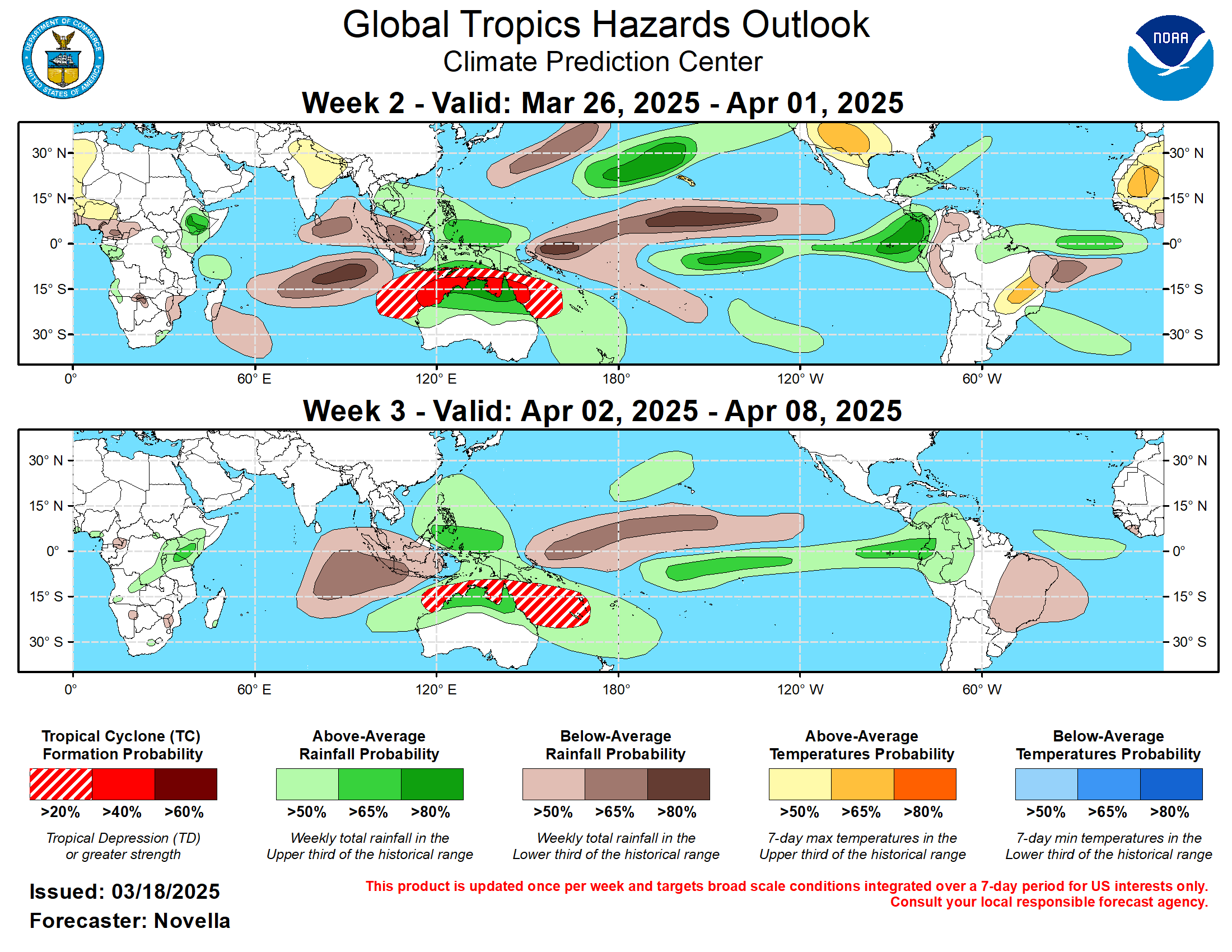This article focuses on what we are paying attention to in the next 48 to 72 hours. The article also includes weather maps for longer-term U.S. outlooks and a six-day World weather outlook which can be very useful for travelers.
First the NWS Short Range Forecast. The afternoon NWS text update can be found here after about 4 p.m. New York time but it is unlikely to have changed very much from the morning update. The images in this article automatically update.
Short Range Forecast Discussion
NWS Weather Prediction Center College Park MD
Thu Jun 27 2024
Valid 12Z Thu Jun 27 2024 – 12Z Sat Jun 29 2024…Flash flooding and severe weather threat across portions of the
northern/central Plains Thursday expands into the Midwest Friday……Dangerously hot conditions continue over portions of the southern
Plains……Monsoon-like conditions persist for the Four Corners Region…
An upper-level trough passing over the Pacific Northwest and the Rockies
will begin to overspread the northern/central High Plains Thursday
afternoon. Lee cyclogenesis will lead to a deepening surface low over the
northern High Plains, with strengthening wind fields helping to reinforce
a warm front lifting northeastward across the High Plains and a trailing
cold front extending southwest into the Rockies. Scattered thunderstorm
development is expected Thursday afternoon in the presence of moist,
upslope flow. Ample instability and strengthening wind fields will promote
some more intense storms, with the Storm Prediction Center issuing an
Enhanced Risk of severe weather (level 3/5) for the threat of very large
hail and a few tornadoes. Storms will likely increase in coverage into the
evening given enhanced forcing along the cold/occluded front, with a line
of storms expected to propagate eastward with a threat for significant
damaging winds. Some locally heavy downpours will also be possible given
anomalously high moisture available. A Slight Risk of Excessive Rainfall
(level 2/4) extends east through North Dakota as more widespread storms
and heavy rainfall are expected with the eastward moving convective
system, and some scattered flash flooding is possible. A similar scenario
exists further south as more widespread, heavy downpour producing storms
are expected to organize and grow upscale along and ahead of the
northeastward moving warm front. Another Slight Risk of Excessive Rainfall
is in place for northern Kansas and southern Nebraska to cover the threat
for some scattered flash flooding here as well.The upper-level trough/surface frontal system will continue eastward on
Friday, bringing storm chances to the Upper/Middle Mississippi Valley and
Great Lakes region back southwest along the cold front through the central
Plains. Initial storm focus will be ahead of the northeastward lifting
warm front over the Middle Mississippi Valley, with the chance storms to
the west overnight Thursday persist across the region. Then, later in the
afternoon, a renewed round of storms is expected along the increasingly
east-to-west oriented cold front. Storm motions relatively parallel to the
boundary will bring a higher threat for heavier rain totals as storms
repeat over the same regions, with a Slight Risk of Excessive Rainfall
extending from the Upper/Middle Mississippi Valley west through the Middle
Missouri Valley. More sensitive conditions over the area due to recent
heavy rainfall will increase the risk for flash flooding. In addition,
there is another Slight Risk of severe weather (level 2/5) over the same
region and west to the central High Plains with large hail, damaging
winds, and a few tornadoes all anticipated.To the south, temperatures will remain dangerously hot over the southern
Plains under the influence of an upper-level high over the
Southwest/south-central U.S. Forecast highs Thursday will range from the
upper-90s to low-100s from central/northern Texas west through the
southern High Plains. Higher humidity over portions of central/northern
Texas into southern Oklahoma have prompted Heat Advisories as Heat Index
values may reach as high as 110. Hotter temperatures will flow back
northward following the warm front on Friday, with highs in the upper 90s
to low 100s reaching up into portions of the central Plains. Very warm
lows in the upper 70s to lower 80s will provide little relief overnight.
An upper-level shortwave dipping down into the Southeast and interacting
with a quasi-stationary frontal boundary will bring shower and storm
chances as well as some relief from the intense heat to most of the Lower
Mississippi Valley and Southeast. Forecast highs will remain in the upper
80s to low 90s over the next couple of days. However, areas of coastal
Georgia north through the Carolinas to the southeast of the boundary will
stay hot, with highs in the mid-90s and heat indices potentially reaching
into the low 100s. Unfortunately, upper-level ridging expanding over the
southern tier of the country will begin to bring more widespread heat back
to the region this weekend.Monsoon-like conditions will persist over the Four Corners region Thursday
with the upper-level high overhead continuing to steer tropical moisture
northward. The upper-level trough arriving from the west will help to
encourage scattered thunderstorms with the threat for locally heavy
downpours. A Slight Risk of Excessive Rainfall covers portions of western
New Mexico north through western Colorado and far eastern Utah for the
risk of some flash flooding. The trough will help to break down the
upper-high as it moves eastward on Friday, helping to reduce the influx of
moisture and keep the highest storm chances and risk for some isolated
flash flooding limited to southeastern Arizona.
To get your local forecast plus active alerts and warnings click HERE and enter your city, state or zip code.
Learn about wave patterns HERE.
Then, looking at the world and of course, the U.S. shows here also. Today we are looking at precipitation.
Please click on “Read More” below to access the full Daily Report issued today.
| Notices: What would you like to learn about? Please provide that to me via the comment section at the end of the article. |
Now more detail on the 48-Hour Forecast (It is a 48 to 72 Hour Forecast actually)
Daily weather maps. The Day 1 map updates twice a day and the Day 2 and 3 maps update only once a day. These maps update automatically. But if that does not happen, you can get updates by clicking HERE
TODAY (or late in the day the evening/overnight map will appear) (Key to surface fronts shown on maps and you will then also be able to insert a city name or zip code and get a local NWS forecast).
TOMORROW
NEXT DAY
We have a new animation of the forecast which shows how things may play out over the next 60 hours. To update click ANIMATION. Doing so will get you to the dashboard. You can then step through the animation or hit LOOP on the upper right of the display. You will have to hit the back arrow ← at the top left on your computer to get back into this article. It is a little more trouble than before but I think NOAA scrapped the animation routine I was using so we have to keep up with “progress”.
The NWS Climate Prediction Center’s: Watches, Warnings, and Advisories plus other information can be found HERE. That takes you to the NWC Severe Weather Site. From there you can select among many categories of information. Remember to hit the back arrow ← at the top left of your screen to return to this article.
ATMOSPHERIC RIVERS
This tells us what is approaching the West Coast. Click HERE to update If I have not gotten around to doing the update. Here is some useful information about Atmospheric Rivers.
Below is the current five-day cumulative forecast of precipitation (Updates can be found HERE)
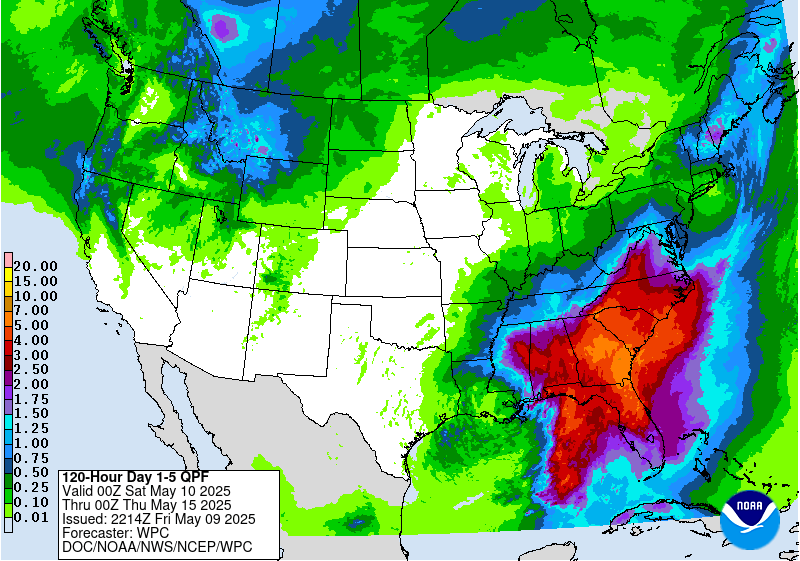
Ski SnowReports will Resume in the Fall.
Now we look at Intermediate-Term “Outlook” maps for three time periods. Days 6 – 10, Days 8 – 14, and Weeks 3 and 4. An outlook differs from a forecast based on how NOAA uses these terms in that an “outlook” presents information as deviation from normal and the likelihood of these deviations.
Below are the links to obtain updates and additional information. They are particularly useful if you happen to be reading this article significantly later than when it was published. I always try to provide readers with the source of the information in my articles. These links may also be useful for those viewing this article on a cell phone or other small screen.
| Days 6 – 10 (shown in Row 1) | Days 8 – 14 (Shown in Row 2) | Weeks 3 and 4 (Shown in Row 3 but updates only on Fridays) |
| https://www.cpc.ncep.noaa. gov/products/predictions/610day/ | https://www.cpc.ncep .noaa.gov/products/predictions/814day/ | https://www.cpc.ncep.noaa.gov/products/predictions/WK34/ |
Showing the actual maps. They should now update automatically. The Week 3 – 4 Outlook only updates on Fridays. So below is what I call the Intermediate-term outlook. On Fridays, it extends out 28 Days. That declines day by day so on Thursday it only looks out 22 days until the next day when the Week 3 – 4 Outlook is updated and this extends the outlook by one additional week.
| 6–
10
|
|
|
| 8–
14 |
|
|
| 3–
4 |
|
|
HAZARDS OUTLOOKS
Click here for the latest complete Day 3 -7 Hazards forecast which updates only on weekdays. Once a week probably Monday or Tuesday I will update the images. I provided the link for readers to get daily updates on weekdays. Use your own judgment to decide if you need to update these images. I update almost all the images Friday Night for the weekend edition of this Weather Report. So normally readers do not need to update these images but if the weather is changing quickly you may want to.
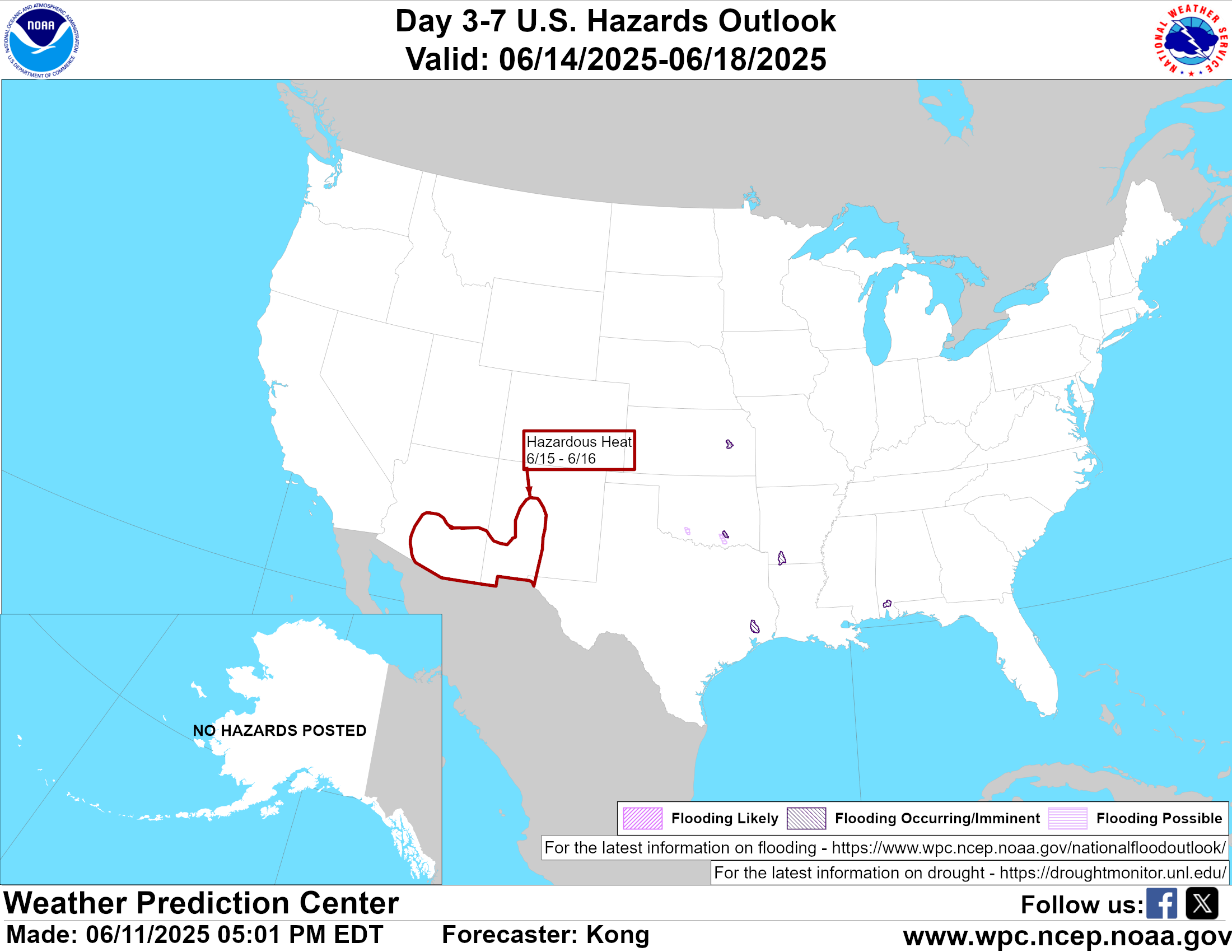
Temperature month to date can be found at https://hprcc.unl.edu/products/maps/acis/MonthTDeptUS.png
Precipitation month to date can be found at https://hprcc.unl.edu/products/maps/acis /MonthPNormUS.png
World Forecast [that website is has been intermittent so be patient]
Below are the Day 1 -3 and 4-6 forecasts for temperature and precipitation. Updates and much additional information can be obtained HERE
World Temperature Anomalies

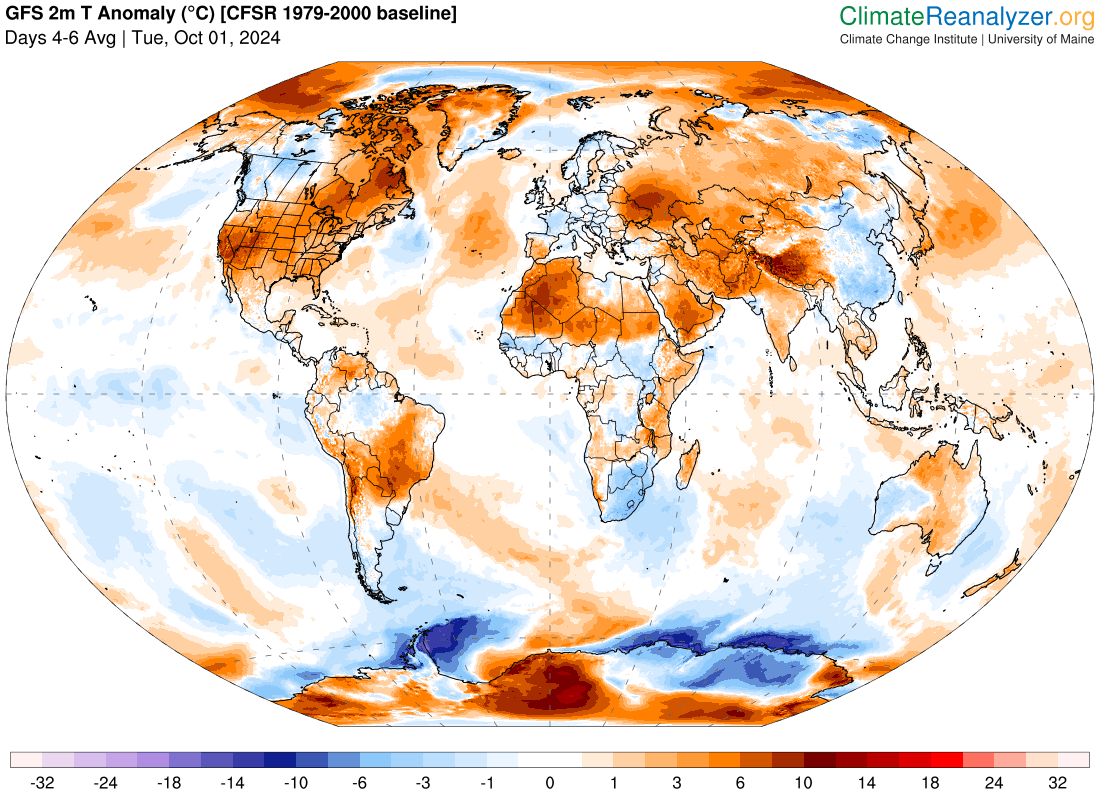
World Accumulated Precipitation
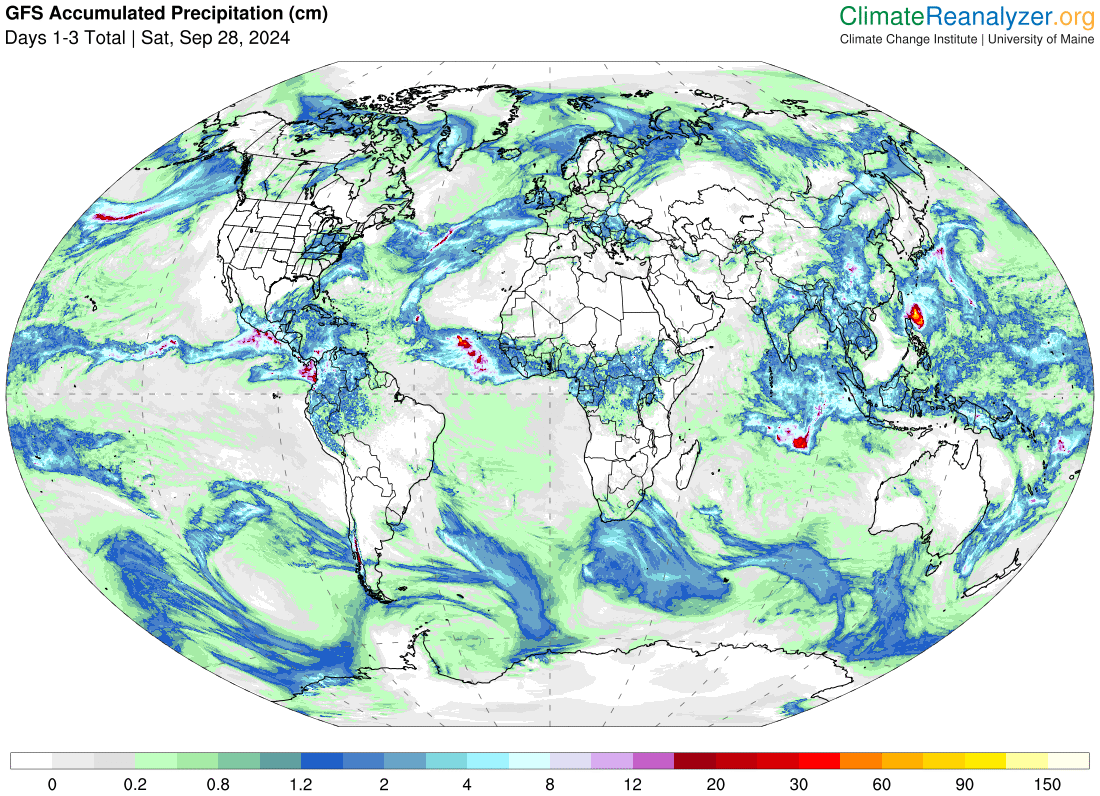

This information is provided by the University of Maine. They draw upon many different sources. There is a lot of information available at the link provided. I have just provided two useful forecasts. There are probably over a hundred different forecasts available from this source.
Worldwide Tropical Forecast (This is a NOAA Product)
This graphic updates on Tuesdays) If it has not been updated, you can get the update by clicking here Readers will only have to do that if they are reading this article much later than the date of it being published.
Information on Tropical Storms can be found HERE. Western Pacific information can be found HERE. Note that unless there is an out-of-season storm the below images will not update until the National Hurricane Center starts their seasonal update of these maps on June 1. I include them simply because there can be an out-of-season event in which case it should show up in these maps.


–
| I hope you found this article interesting and useful. |

